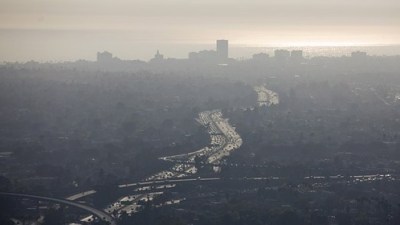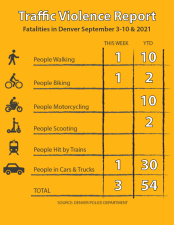It’s Official: Widening I-70 Among America’s Most Wasteful Highway Boondoggles
In front of the rumbling I-70 underpass at the corner of 46th and Columbine, a stone’s throw from kids playing tag during Swansea Elementary School’s recess, CoPIRG Director Danny Katz told reporters Tuesday that taxpayers could save at least $58 million if Colorado DOT nixed its plan to widen the interstate by four lanes.

Katz was answering questions about a new report by U.S. PIRG, Highway Boondoggles 2, that calls out state DOTs around the country for their addiction to irresponsible highway expansion projects. The I-70 boondoggle is one of 12 featured.
“Those lanes of traffic are not gonna solve our congestion and they’re gonna waste taxpayer dollars at a time when we could be using them to be more creative, efficient, and effective,” Katz said.
The viaduct needs to be replaced before it crumbles. Fixing an aging bridge is one thing, but using that as an excuse to widen the highway — especially in the name of fixing congestion — is another.
Creating more car lanes attracts more cars, creating more congestion. Five years after the T-REX project that widened I-25, congestion reached pre-construction levels, according to CoPIRG. The report lists other examples too: The Katy Freeway in Texas, I-270 in Maryland, I-405 in Los Angeles, and U.S. 101 in SIlicon Valley all became more clogged after adding lanes.
The I-70 expansion costs between $1.1 billion and $1.8 billion. The savings from fixing the viaduct without widening the highway, said Katz, could go toward things that actually help congestion by taking cars off the road — really good transit, better walking and biking infrastructure, incentives to carpool, telecommute, or avoid rush hour travel. Instead of adding lanes, maybe the roads agency should leverage connected vehicles to deal with the state’s rapid population growth, Katz said. (Isn’t what the DOT’s Road X initiative is all about?)
“If you think of all those people [moving here] as cars, it’s pretty mind boggling and we’re not gonna be able to widen our highways enough to accommodate all them,” Katz said. “But if we think of them as people, and [ask] how do we move people more efficiently and effectively, then we could come up with cheaper and better alternatives.”
According to the CoPIRG, Colorado DOT doesn’t “account for changing transportation trends or the negative impact that vehicle pollution has on community health and the environment.” Indeed, the agency could be creating the very congestion it aims to fix.
“We’re seeing a change in travel patterns, especially among Millennials,” Katz said. “This is the largest age group in our country right now and they’re really the ones we should be building the future transportation system for. They’re driving less, and want to live in areas where they don’t need a car.”
With last week’s release of the I-70 environmental impact study, the widening seems like a foregone conclusion. Still, Katz encouraged people to use “this moment” to comment on the plan and figure out another course of action. One reporter asked Katz if he had an alternative plan, given that Colorado DOT doesn’t.
“Yeah,” he said. “Not widening it.”


